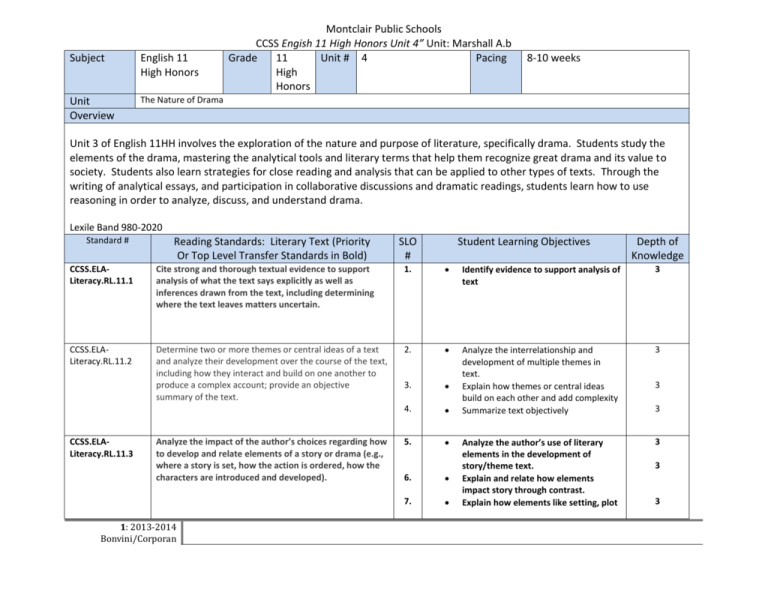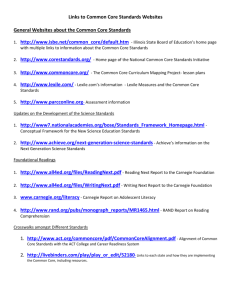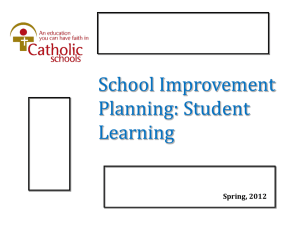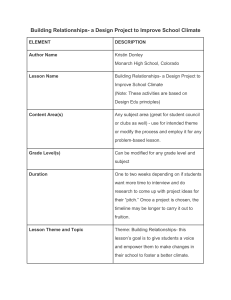Montclair Public Schools CCSS Engish 11 High Honors Unit 4” Unit
advertisement

Subject English 11 High Honors Unit Overview The Nature of Drama Montclair Public Schools CCSS Engish 11 High Honors Unit 4” Unit: Marshall A.b Grade 11 Unit # 4 Pacing High Honors 8-10 weeks Unit 3 of English 11HH involves the exploration of the nature and purpose of literature, specifically drama. Students study the elements of the drama, mastering the analytical tools and literary terms that help them recognize great drama and its value to society. Students also learn strategies for close reading and analysis that can be applied to other types of texts. Through the writing of analytical essays, and participation in collaborative discussions and dramatic readings, students learn how to use reasoning in order to analyze, discuss, and understand drama. Lexile Band 980-2020 Standard # Reading Standards: Literary Text (Priority Or Top Level Transfer Standards in Bold) SLO # Student Learning Objectives Depth of Knowledge CCSS.ELALiteracy.RL.11.1 Cite strong and thorough textual evidence to support analysis of what the text says explicitly as well as inferences drawn from the text, including determining where the text leaves matters uncertain. 1. Identify evidence to support analysis of text 3 CCSS.ELALiteracy.RL.11.2 Determine two or more themes or central ideas of a text and analyze their development over the course of the text, including how they interact and build on one another to produce a complex account; provide an objective summary of the text. 2. 3 3. 4. Analyze the interrelationship and development of multiple themes in text. Explain how themes or central ideas build on each other and add complexity Summarize text objectively 5. Analyze the author’s use of literary elements in the development of story/theme text. Explain and relate how elements impact story through contrast. Explain how elements like setting, plot 3 CCSS.ELALiteracy.RL.11.3 Analyze the impact of the author’s choices regarding how to develop and relate elements of a story or drama (e.g., where a story is set, how the action is ordered, how the characters are introduced and developed). 1: 2013-2014 Bonvini/Corporan 6. 7. 3 3 3 3 and characterization impact story’s theme. Analyze multiple interpretations of a story, drama, or poem (e.g., recorded or live production of a play or recorded novel or poetry), evaluating how each version interprets the source text. (Include at least one play by Shakespeare and one play by an American dramatist.) 8. 9. CCSS.ELALiteracy.RL.11.9 Demonstrate knowledge of eighteenth-, nineteenth- and early-twentieth-century foundational works of American literature, including how two or more texts from the same period treat similar themes or topics. 10. CCSS.ELALiteracy.RL.11.10 By the end of grade 11, read and comprehend literature, including stories, dramas, and poems, in the grades 11– CCR text complexity band proficiently, with scaffolding as needed at the high end of the range. 11. 12. Reading Standards: Informational Text (Priority or Top Level Transfer Standards in Bold) SLO # CCSS.ELALiteracy.RI.11.8 Delineate and evaluate the reasoning in seminal U.S. texts, including the application of constitutional principles and use of legal reasoning (e.g., in U.S. Supreme Court majority opinions and dissents) and the premises, purposes, and arguments in works of public advocacy (e.g., The Federalist, presidential addresses). 13. Analyze and explain the use of argumentation in influential U.S. works 3 CCSS.ELALiteracy.RI.11.9 Analyze seventeenth-, eighteenth-, and nineteenthcentury foundational U.S. documents of historical and literary significance (including The Declaration of Independence, the Preamble to the Constitution, the Bill of Rights, and Lincoln’s Second Inaugural Address) for their themes, purposes, and rhetorical features. 14. Examine historical and literary significant documents for themes, purpose, and rhetorical features. 3 CCSS.ELA- By the end of grade 11, read and comprehend literary 15. Determine level of comprehension for 3 CCSS.ELALiteracy.RL.11.7 Standard # 2: 2013-2014 Bonvini/Corporan Compare and contrast interpretations of the same work/theme. Evaluate varied interpretations 3 Examine how two or more works from a similar period treat similar themes. 2 Determine level of comprehension for grade level text. Apply appropriate strategies to increase understanding. Student Learning Objectives 3 3 3 Depth of Knowledge Literacy.RI.11.10 nonfiction in the grades 11–CCR text complexity band proficiently, with scaffolding as needed at the high end of the range. 16. Writing Standards (Priority or Top Level Transfer Standards in Bold) SLO # CCSS.ELALiteracy.W.11.1 Write arguments to support claims in an analysis of substantive topics or texts, using valid reasoning and relevant and sufficient evidence. 17. Develop an argument supported by claims using reason and evidence 4 CCSS.ELALiteracy.W.11.2 Write informative/explanatory texts to examine and convey complex ideas, concepts, and information clearly and accurately through the effective selection, organization, and analysis of content. 18. 3 19. 20. Write text that informs/explains complex ideas and concepts. Compose with clarity, organization, and analysis. Investigate concepts through the use of appropriate selection, organization, and analysis of concepts. 21. Plan and develop a narrative that includes effective techniques, details, and structured sequenced events. Standard # grade level text. Apply appropriate strategies to increase understanding. Student Learning Objectives 2 Depth of Knowledge 3 3 CCSS.ELALiteracy.W.11.3 Write narratives to develop real or imagined experiences or events using effective technique, well-chosen details, and well-structured event sequences. CCSS.ELALiteracy.W.11.3a Engage and orient the reader by setting out a problem, situation, or observation and its significance, establishing one or multiple point(s) of view, and introducing a narrator and/or characters; create a smooth progression of experiences or events. 22. Create a problem, situation, or idea within a story and establish its’ significance through narrative techniques. 3 CCSS.ELALiteracy.W.11.3b Use narrative techniques, such as dialogue, pacing, description, reflection, and multiple plot lines, to develop experiences, events, and/or characters. 23. Implement narrative techniques to develop theme, tone, and plot. 3 CCSS.ELALiteracy.W.11.3c Use a variety of techniques to sequence events so that they build on one another to create a coherent whole and 24. Build coherence in a story through building elements in the service of a 3 3: 2013-2014 Bonvini/Corporan 3 build toward a particular tone and outcome (e.g., a sense of mystery, suspense, growth, or resolution). particular tone or outcome. CCSS.ELALiteracy.W.11.3e Provide a conclusion that follows from and reflects on what is experienced, observed, or resolved over the course of the narrative. 25. CCSS.ELALiteracy.W.11.9a Apply grades 11–12 Reading standards to literature (e.g., “Demonstrate knowledge of eighteenth-, nineteenth- and early-twentieth-century foundational works of American literature, including how two or more texts from the same period treat similar themes or topics”). CCSS.ELALiteracy.W.11.9b Standard # CCSS.ELALiteracy.SL.11.1a 3 Develop a conclusion that follows and reflects on previous events. 26. Draw information from literary and informational text to support analysis, reflection, and research. 2 Apply grades 11–12 Reading standards to literary nonfiction (e.g., “Delineate and evaluate the reasoning in seminal U.S. texts, including the application of constitutional principles and use of legal reasoning [e.g., in U.S. Supreme Court Case majority opinions and dissents] and the premises, purposes, and arguments in works of public advocacy [e.g., The Federalist, presidential addresses]”). 27. Draw information from literary and informational text to support analysis, reflection, and research. 3 Speaking & Listening Standards (Priority or Top Level Transfer Standards in Bold) Come to discussions prepared, having read and researched material under study; explicitly draw on that preparation by referring to evidence from texts and other research on the topic or issue to stimulate a thoughtful, well-reasoned exchange of ideas. SLO # 4: 2013-2014 Bonvini/Corporan 28. Student Learning Outcomes 29. 30. Demonstrate preparedness by referring to evidence from topic or text in class discussion. Use annotations of text or notes/journals as evidence of thinking. Use thoughts to stir and promote thoughtful discussion. Depth of Knowledge 3 3 3 CCSS.ELALiteracy.SL.11.3 Evaluate a speaker’s point of view, reasoning, and use of evidence and rhetoric, assessing the stance, premises, links among ideas, word choice, points of emphasis, and tone used. CCSS.ELALiteracy.SL.11.1c Propel conversations by posing and responding to questions that probe reasoning and evidence; ensure a hearing for a full range of positions on a topic or issue; clarify, verify, or challenge ideas and conclusions; and promote divergent and creative perspectives. 31. Appraise a speaker’s point of view using reason, evidence, and rhetoric. 3 32. 3 33. 34. Extend conversation and dialogue through questions that probe reason and evidence. Listen for the full range of positions on topic. Evaluate conflicting viewpoints and promoting divergent perspectives. 3 3 CCSS.ELALiteracy.SL.11.2 Integrate multiple sources of information presented in diverse formats and media (e.g., visually, quantitatively, orally) in order to make informed decisions and solve problems, evaluating the credibility and accuracy of each source and noting any discrepancies among the data. 35. Integrate and evaluate information from a variety of sources. 3 CCSS.ELALiteracy.SL.11.6 Adapt speech to a variety of contexts and tasks, demonstrating a command of formal English when indicated or appropriate. 36. Decide on appropriate speech style for given situation and adapts to the use of formal English when appropriate. 3 Standard # CCSS.ELALiteracy.L.11.1a Language Standards (Priority or Top Level Transfer Standards in Bold) Apply the understanding that usage is a matter of convention, can change over time, and is sometimes contested. 5: 2013-2014 Bonvini/Corporan SLO # Student Learning Outcomes 37. 38. Examine reliable references to make appropriate decisions in terms of usage. Survey their knowledge of language and vocabulary in reading, writing, speaking and listening. Depth of Knowledge 2 2 CCSS.ELALiteracy.L.11.1b Resolve issues of complex or contested usage, consulting references (e.g., Merriam-Webster’s Dictionary of English Usage, Garner’s Modern American Usage) as needed. 39. Consult references to resolve issues of contested usage. 1 CCSS.ELALiteracy.L.11.2a Observe hyphenation conventions. 40. Demonstrate use hyphenation conventions. 1 CCSS.ELALiteracy.L.11.3a Vary syntax for effect, consulting references (e.g., Tufte’s Artful Sentences) for guidance as needed; apply an understanding of syntax to the study of complex texts when reading. 41. CCSS.ELALiteracy.L.11.4a Use context (e.g., the overall meaning of a sentence, paragraph, or text; a word’s position or function in a sentence) as a clue to the meaning of a word or phrase. 42. Use varying syntax for effect. Demonstrate the use of context clues to explain meaning. 2 2 Big Ideas: Marshall A.c Drama has been used by people throughout history and the world to express and claim their humanity. Playwrights draw from their own lives and observations for material for their plays. Playwrights are influenced by their contemporary culture, which is manifest through the style and subject matter of their work. Playwrights use particular dramatic conventions in different ways to push boundaries, to achieve particular effects and to help convey the meaning in plays. Essential Questions: Marshall A.c, C.c How is a play similar to and different from a novel, short story, or poem? What are the characteristics of a classical tragedy? How has drama changed over time (from Greece to today)? How does an author create meaning in drama? How are strategies for reading/viewing drama different than those for reading other fiction, non-fiction, or poetry? 6: 2013-2014 Bonvini/Corporan How is a dramatic work a product of and indicative of the time during which it was written? What lessons may be learned from the reading of classical and modern drama? Assessments: Marshall A.d, D.c Quizzes using context, multiple-choice questions, writing sentences and definitions. Reading checks and quizzes, small and class discussion; completion of worksheets on specific topics. Comprehensive test Individual and group presentations Analytical essays Response journals Reading strategies for poems. Memoir analysis and writing College essay Journal Writing-both on literature and other topics Literature discussion-various Character analysis –(verbal and in groups) Persuasive writing Analysis of literary devices-metaphor, simile etc. Think-pair-share Reading for Hot Spots Silent discussions Writing conferences Quizzes, Test, short reflective and analytical papers Key Vocabulary Mystery plays Seneca Plays Modern Drama Elizabethan/Jacobean Morality Plays Ancient Greek Drama Revenge Tragedy Tragic Hero Hubris Catharsis Deus Ex Machina Act Antagonist Aside Catastrophe Soliloquy Character: flat ,round, static, dynamic, stock pathos Crisis conflict: internal, external epilogue hamartia exposition lusis desis denouement foil plot peripeteia anagnorisis Antagonist protaganist en media res prologue monologue dialogue scene mimesis spectacle Realism melody Unities diction romantic satire melodrama suspense didactic strophe chorus antistrophe ode Naturalism Suggested Resources (These are recommended; you may select others as long as they are aligned to the standards and Lexile levels in this unit of study.) Drama Oedipus Rex –Sophocles NP Hamlet- William Shakespeare Lexile 1490 Othello- William Shakespeare Lexile 1390 A Doll’s House – Henrik Ibsen NP 7: 2013-2014 Bonvini/Corporan An Enemy of the People- Henrik Ibsen NP Trifles- Susan Glaspell NP The Stronger- August Strinderg NP Beauty –Jane Martin NP Tape- Jose Rivera NP The Glass Menagerie-Tennessee Williams NP Twilight:Los Angelos-Anna Deaveare Smith NP Los Vendidos- Luis Valdez NP Tartuffe- Moliere NP Am I Blue- Beth Henley NP Death of a Salesman- Arthur Miller NP Fences- August Wilson NP The Piano Lesson –August Wilson NP Non-Fiction Poetics-Aristotle Lexile 1410 “Tragedy and the Common Man”-Arthur Miller Lexile 1500 “On Tragic Character”-Aristotle Lexile 1400 “On the Oedipus Complex”-Sigmund Freud Lexile 1860 “On Repression in Hamlet”-Sigmund Freud Lexile 1800 “On Shakespare’s Character’s –Samual Johnson lexile 980 “Ophelia’s Desperation”- Joan Montgomery Byles Lexile 2020 “A Look into Black America”-August Wilson Lexile 1550 “What is Black Theater?” –Amari Baraka Lexile 1300 “Declaration of the Sentiments” Lexile Score 1490 Other resources Perrine’s: Literature Structure, Sound and Sense by Thomas Arp Common Core State Standards Initiative http://www.corestandards.org/ Partnership for Assessment for College and Careers http://www.parcconline.org/ The Lexile Framework for Reading: http://www.lexile.com/ Project Gutenberg: http://www.gutenberg.org JSTOR EBSCOhost Oxford English Dictionary Encyclopedia Britannic CCSS Framework Appendix A: Grade Level Text Complexity (p.5) 8: 2013-2014 Bonvini/Corporan CCSS Framework Appendix C: Writing Exemplars 9: 2013-2014 Bonvini/Corporan






